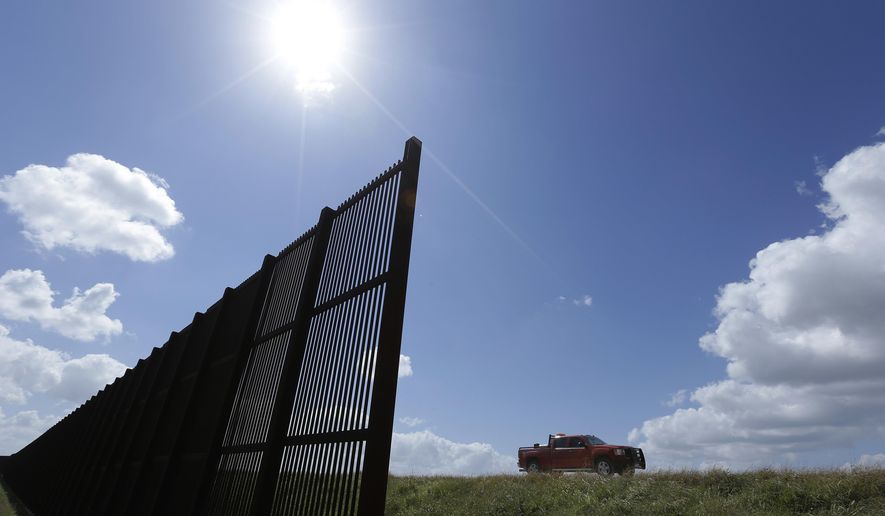WASHINGTON (AP) - President Donald Trump’s vow to accelerate construction of a “contiguous, physical wall” along the Mexican border is slamming into a Washington reality - who’s going to pay for it and how?
Not us, say the Mexicans.
Instead, U.S. taxpayers will foot the bill, starting with money already in the Department of Homeland Security account that amounts to a small down payment. Then it’s up to the Republican-led Congress to come up with $12 billion to $15 billion more, according to an estimate offered by Senate Majority Leader Mitch McConnell, R-Ky., on Thursday from a GOP issues retreat in Philadelphia.
GOP leaders refused to commit to paying for the wall with spending cuts elsewhere in the budget. That could mean costs would be paid for by adding to the government’s $20 trillion debt. Press Secretary Sean Spicer Thursday floated the idea of a 20 percent tariff on Mexican imports.
On Wednesday, Trump promised “immediate construction” would begin on the border wall, telling ABC News that planning is starting immediately. He again vowed that Mexico would pay the U.S. back, though he offered no details.
It is true there is a small amount available now in the Department of Homeland Security accounts dedicated to “border security fencing, infrastructure, and technology” - $100 million, by one congressional estimate - that would permit work to get immediately under way.
So far, thanks to spending in the late 2000s, Congress has provided about $2.3 billion to construct 654 miles of fencing and vehicular blockades. But Trump has promised a wall, not just fencing, and it’s not a universally popular idea by any stretch.
“The facts have not changed. Building a wall is the most expensive and least effective way to secure the border,” said GOP Rep. Will Hurd, whose sprawling West Texas swing district encompasses more than 800 miles of the border. “Many areas in my district are perfect examples of where a wall is unnecessary and would negatively impact the environment, private property rights and economy.”
GOP members of the appropriations committees are more likely to take a green eyeshade approach to the money since they are familiar with the likely trade-offs.
“There’s any number of complications,” said Rep. Harold Rogers, R-Ky., former House Appropriations Committee Chairman, citing obstacles such as Indian reservations and national parks and forests. And much of the remaining 1,300 miles is very rough terrain, with steep construction costs and a limited return for the dollar. “It’s expensive and it’s complicated.”
Hundreds of miles of the border are so rugged and inhospitable that it doesn’t make sense to even try to build.
And in Texas, almost all of the land along the border is privately owned. When former President George W. Bush tried to build border fencing starting in 2006, he faced stiff opposition from local ranchers and farmers, many of whom took the government to court on plans to use their land.
In many areas along the Rio Grande the fencing is built well inside the United States, as far as a mile north of the Rio Grande, to ensure that the structure doesn’t interfere with the flow of the river or is built on solid ground. The middle of the channel marks the internal border and a 1970 treaty with Mexico requires that structures built there not interfere with water flow.
“We have built a fence along the border almost as much as we possibly can without violating tribal laws, environmental requirements, and taking over peoples’ personal, private property,” said Michelle Mrdeza, who worked for the House Appropriations panel during the fence debate of the mid-2000s.
The existing blockade - roughly 350 miles to block pedestrians and 300 miles to block vehicles - has already been built along the southern border. That fencing was built in the areas that are most vulnerable to illegal crossings.
“Insofar as the problem is a physical barrier, we’ve basically addressed that issue,” said Rep. David Price, D-N.C., who chaired the congressional panel that funded the border fence when Democrats controlled Congress. “This focus, this fixation on a wall and pouring untold billions of dollars into a wall, is foolishness.”
Cost estimates prepared a decade ago already varied widely. A 2009 Government Accountability Office analysis put costs at $6.5 million a mile for pedestrian fencing and $1.8 million per mile for vehicular blockades. An actual wall constructed of concrete and steel would be more costly and difficult.
Trump has repeatedly promised that Mexico will pay for his wall, though neither he nor his allies in Congress are able to articulate how. The president of Mexico is emphatic that his country will not pick up the tab.
“I regret and reject the decision of the U.S. to build the wall,” Mexican President Enrique Pena Nieto said Wednesday in a nationally televised address in his country. “I have said time and again, Mexico will not pay for any wall.”
Already, U.S. agencies have been told to scrub their budgets for savings that could be used for the wall.
“These taxpayer dollars would be better spent on investing … to find cures for cancer and other diseases, spending on hospitals and doctors to care for our veterans, helping communities with clean water investments, supporting police in our communities,” said Sen. Pat Leahy, D-Vt.
___
This story has been corrected to change the day to Wednesday in the fifth paragraph.




Please read our comment policy before commenting.